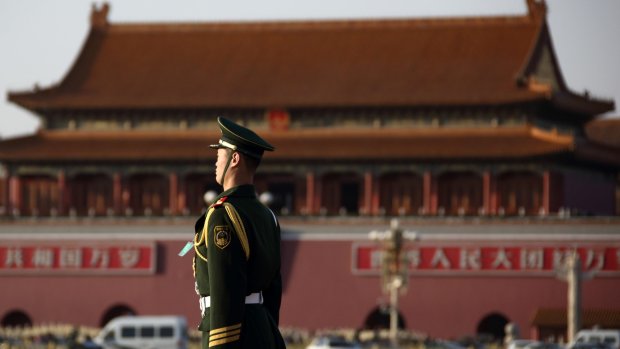Please read in conjunction with our pieces on Friedrich List
China's global investment game plan has hit a wall

Rhetoric about open investment does not add up to much when the objectives are strategic rather than commercial.
“Based on the aspiration of promoting the silkroad spirit centering on peace, cooperation, openness, inclusiveness, mutual learning and mutual benefits and aspiration to further enrich such spirit in keeping with the new era; welcoming and supporting China’s initiative to jointly promote the Silk Road Economic Belt and the 21st Century Maritime Silk Road (hereafter the Belt and Road Initiative); willing to enhance practical cooperation within the framework of jointly building the Belt and Road, the parties decide … ”
So opens Victoria’s memorandum of understanding with China, signed by Premier Dan Andrews. Peace, co-operation and openness? Australian journalists fleeing from China after being heavied by police in their homes at night may have a view on that.

It true that the Port of Darwin, owned by China, is now a part of the BRI – an uncomfortable truth. But the 20 per cent of the Port of Melbourne owned by China does not yet qualify it for being on the Maritime Silk Road. And Victoria is certainly on the other side of the world to China’s six economic belts.
Yet Victoria apparently understands that it is going to help build something that is not in Australia’s interest, and welcome and support it, ushering in a “new era”. What is the nature of this “new era”? Recently in these pages I looked at China’s imports as part of that “new era”. What about the international investment side?
China’s state-linked companies buy enterprises in the West where there is technology transfer that they seek, or where owning a company helps to vertically integrate goods and services into Chinese industrial supply chains.
These acquisitions are shown (ignoring deals of less than $US100million) in the “stacked area” part of the chart. China is also a huge builder of infrastructure. Its construction companies are the largest in the world. These deals are shown by the lines in the chart.
Three elements of the picture are interesting.
First, prior to 2018 the pace of large-scale acquisitions of companies was breathtaking, with the Five Eyes plus Japan and Europe figuring strongly. That of course is because the desired technology sits in those countries. Between 2005 and 2019 there were more than 150 such large-scale acquisitions (and many smaller ones).
Buying or taking Western technology has been critical to this process. But openness has been a one-way street.
Second, from 2018 to today, these deals have collapsed. Western governments have finally woken up to what is going on. The underlying reason for this "awakening" is that we are not talking about private companies' deals based on market pricing and open capital markets. Rather, it is a case of companies linked to the Communist Party acting in concert to achieve strategic rather than economic goals.
“Made in China 2025” is one such goal. State-linked companies will work to ensure China becomes the high-tech hub within the BRI network, locking in standards and shifting lower value-added activities to other countries along the Silk Road.
Buying or taking Western technology has been critical to this process. But openness has been a one-way street. China is affronted when its acquisitions are declined, but routinely declines or impedes strategic competitor companies from the West.
Third, China’s strategic BRI goals have meant that there is less emphasis on infrastructure construction in the West. The gap between the total line and the minuscule amounts for the Fives Eyes plus Japan and Europe represents BRI country construction contracts. The latter remains strong and is accelerating in 2020 (the dashed line for the totals shows what happened in the first six months of this year alone).
There are serious concerns regarding the whole infrastructure side of China’s activities abroad. Where there is a strong strategic interest with possible military considerations – such as building energy pipelines from south-east Asian countries to China (to avoid using the Strait of Malacca) – funding is provided to cash-strapped governments.
In these cases, Chinese construction companies invariably win contracts through non-open tender processes. The inability of a client government to pay results in China taking equity control of the assets. Where electricity generation infrastructure is concerned, a "fund-build-operate-transfer approach" is used, again with Chinese construction companies invariably winning the contract.
Systematic underbidding
In other cases, Chinese companies win contracts by systematically underbidding on costs. A part of this is the state bank impact that lowers the cost of capital – itself a distortion. But more is involved. China’s debt-laden, loss-making companies often depend on winning more deals to stay in business. The more deals you can clinch globally, the more revenues allow companies to cover their variable costs and avoid defaults. This risks future financial crises if deal-flow slows or stops.
An Oxford academic study based on detailed project data has shown that Chinese infrastructure companies on average underestimate costs by 30.6 per cent, and that finishing on time is at the expense of quality and the environmental.
An interesting footnote here concerns Victoria’s high capacity metro train project. There has been a massive cost blowout on the tunnelling side (China’s John Holland is part of the consortium). With respect to the trains, the winning consortium bid 38.6 per cent lower than the state government’s own benchmarking, and serious delays have already occurred. Without attributing blame, these outcomes are consistent with the global pattern found in the Oxford study.
More generally, Australia fits the global picture fairly well: little on the infrastructure side, and acquisitions of companies meeting China’s strategic goals.
Resource security: 34 metals acquisitions larger than $US100 million since 2005, worth more than $US33 billion (and plenty more smaller deals).
Energy security: 43 large acquisitions worth more than $US35 billion. If you wonder why it seems so hard for Australia to be sensible on coal, bear in mind that China bought up 15 major coal assets worth more than $US13 billion. Yanzhou Coal Mining (Yankuang Group) has 22 Australian subsidiaries.
Food security: 14 acquisitions worth $US4.5 billion (Tully Sugar, Bellamy's, Kidman, Burra Foods, and rights to develop a large tract of the Ord River Valley).
No comments:
Post a Comment